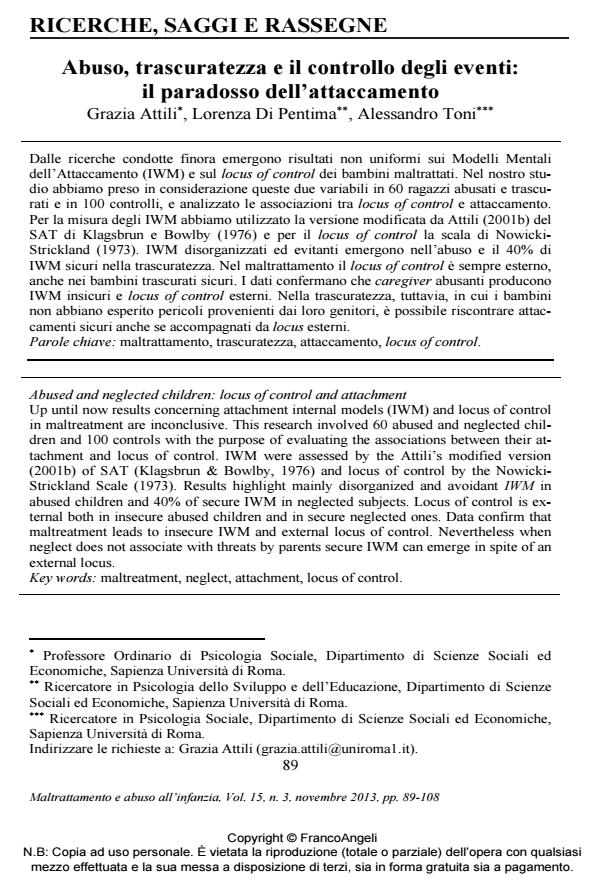Abused and neglected children: locus of control and attachment
Journal title MALTRATTAMENTO E ABUSO ALL’INFANZIA
Author/s Grazia Attili, Lorenza Di Pentima, Alessandro Toni
Publishing Year 2013 Issue 2013/3
Language Italian Pages 20 P. 89-108 File size 755 KB
DOI 10.3280/MAL2013-003005
DOI is like a bar code for intellectual property: to have more infomation
click here
Below, you can see the article first page
If you want to buy this article in PDF format, you can do it, following the instructions to buy download credits

FrancoAngeli is member of Publishers International Linking Association, Inc (PILA), a not-for-profit association which run the CrossRef service enabling links to and from online scholarly content.
Up until now results concerning attachment internal models (IWM) and locus of control in maltreatment are inconclusive. This research involved 60 abused and neglected children and 100 controls with the purpose of evaluating the associations between their attachment and locus of control. IWM were assessed by the Attili’s modified version (2001b) of SAT (Klagsbrun & Bowlby, 1976) and locus of control by the Nowicki- Strickland Scale (1973). Results highlight mainly disorganized and avoidant IWM in abused children and 40% of secure IWM in neglected subjects. Locus of control is external both in insecure abused children and in secure neglected ones. Data confirm that maltreatment leads to insecure IWM and external locus of control. Nevertheless when neglect does not associate with threats by parents secure IWM can emerge in spite of an external locus.
Keywords: Maltreatment, neglect, attachment, locus of control.
- Reazioni dei genitori in situazioni problematiche e attribuzioni di causa: le aspettative dei bambini maltrattati Grazia Attili, Lorenza Di Pentima, Alessandro Toni, Antonio Roazzi, in MALTRATTAMENTO E ABUSO ALL'INFANZIA 1/2016 pp.89
DOI: 10.3280/MAL2016-001005 - Correlati neuropsicologici e di neuroimaging del maltrattamento e dell'abuso infantili Marco Cavallo, Arianna Signorino, in MALTRATTAMENTO E ABUSO ALL'INFANZIA 3/2015 pp.11
DOI: 10.3280/MAL2015-003002 - Attaccamento, locus of control e quadri sintomatologici: differenze per genere ed età in infanzia e adolescenza Lorenza Di Pentima, Alessandro Toni, Grazia Attili, in RICERCHE DI PSICOLOGIA 2/2019 pp.251
DOI: 10.3280/RIP2019-002003 - Il paradosso del lockdown da COVID-19: cosa accade alle donne e ai minori nei contesti maltrattanti Lorenza Di Pentima, Alessandro Toni, in MALTRATTAMENTO E ABUSO ALL'INFANZIA 3/2021 pp.11
DOI: 10.3280/MAL2021-003002 - L'impatto della violenza assistita sui minori: attaccamento, locus of control ed esiti psicopatologici Lorenza Di Pentima, Alessandro Toni, Grazia Attili, in MALTRATTAMENTO E ABUSO ALL'INFANZIA 2/2021 pp.83
DOI: 10.3280/MAL2021-002006 - Dysfunctional Parental Care and Emotional Dysregulation: A Pilot Study on the Mediating Role of Attachment Styles and Alexithymia in a Sample of Young Women Lorenza Di Pentima, Alessandro Toni, in Journal of Adult Development /2025
DOI: 10.1007/s10804-025-09523-z
Grazia Attili, Lorenza Di Pentima, Alessandro Toni, Abuso, trascuratezza e il controllo degli eventi: il paradosso dell’attaccamento in "MALTRATTAMENTO E ABUSO ALL’INFANZIA" 3/2013, pp 89-108, DOI: 10.3280/MAL2013-003005